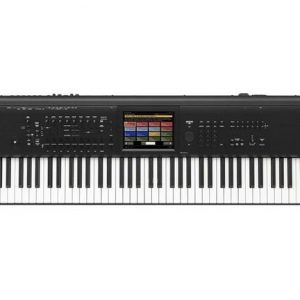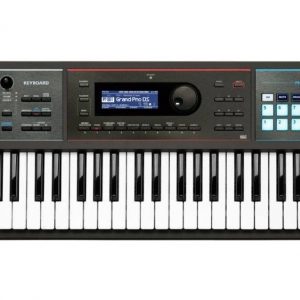Description
Roland Juno-DS88 Synthesizer: A Comprehensive Review
If you are in search of a high-end, affordable synthesizer that can provide a wide range of sounds, then you should consider getting the Roland Juno-DS88. The Roland Juno-DS88 synthesizer is regarded as one of the most versatile and reliable synthesizers on the market, which is designed to provide excellent sound quality, intuitive user experience and playing. We will delve into the features, functionalities and specifications of the Roland Juno-DS88 synthesizer in this comprehensive review.
Design and Build
The Roland Juno-DS88 has an exquisite design that makes it fitting for both live performances and studio sessions. It comes in a matte black finish, which gives it a sleek and modern look. The synthesizer is 1,414mm wide, 273mm deep, 107mm high, making it a highly portable keyboard all thanks to its lightweight and compact design. The Juno-DS88 weighs a mere 16.2kg, which enables you to take it with you anywhere you go.
Keyboard
The Roland Juno-DS88 features an 88-key, weighted keyboard. Unlike many traditional synthesizers in its class, the keys provide a highly realistic textured feel that makes players forget they are playing a digital instrument. The keyboard comes with an adjustable touch response option that ranges from light to heavy. This keyboard allows players to tailor the keys’ sensitivity to their style of play resulting in ultimate user control.
Sound Quality
The Roland Juno-DS88 has a wide range of versatile sounds, which makes it one of the most sought-after synthesizers on the market. It features more than 1,200 sounds, including over 200 completely new patches. The synthesizer comes equipped with the acclaimed SuperNATURAL sound engine, which provides an exceptional faithful representation of natural sound instruments. You can tap into brass instruments, drums, strings, pianos, and so much more.
A powerful built-in processor does not only allow players to create unique sound patches, but its sound engine can create layered, parallel and split tones. The synthesizer comes with an excellent selection of effects depending on the needs of your performance or recording sessions.
The Roland Juno-DS88 synthesizer includes eight-track sequencers with an easy-to-use interface, which is ideal for songwriters seeking inspiring creativity. The sequencer can record up to eight tracks simultaneously, with three options to choose from; pattern sequencer, TR-REC sequencer or linear sequencer.
Connectivity
The Roland Juno-DS88 interface comes with a number of connectivity options including, USB connectivity, 1/8 headphone output, 1/4 microphone input, MIDI in/out, 1/4 stereo output, pedal input and piano-style sustain pedal input. The Roland Juno-DS88 also ships with a free copy of Ableton Live Lite, which makes it easier for creators to get started with this digital audio workstation.
Conclusion
In conclusion, the Roland Juno-DS88 synthesizer is a high-end and affordable synthesizer that offers a broad range of sounds, intuitive design and is highly portable. Its sound quality, building quality, and features are all top-notch. The wide range of versatile sounds, coupled with the eight-track sequencers and a host of connectivity options, provides creative individuals with everything they could ask for in a synthesizer. Overall, this synthesizer is a go-to for anyone that seeks affordability, versatility and great sound quality.
Roland Juno-DS88 properties
| Product name | Juno-DS88 |
| Brand | Roland |
| Type | Keyboard Instruments |
| Keyboard Instrument | Synthesizer |
| Drawbars/Sliders | Yes |
| Pads | Yes |
| Rotary Controls | Yes |








Jesse Matthews –
Very light instrument. Made of plastic, but of very high quality. The knobs work perfectly. Likewise buttons. The main advantage is the sound engines.
Practically the same as in the legendary Montage and there are actually no weaknesses here. The interface requires a bit of practice. It’s not intuitive. However, it doesn’t take too long to master it.
Melody Nolan –
I recently purchased the Roland Juno-DS88 and I must say, it has been quite an experience. As someone who lives in the beautiful city of Braunschweig, I thought it was about time to treat myself with a new synthesizer during my vacation. Little did I know what I was getting myself into!
First things first, the Roland Juno-DS88 boasts an impressive range of features for both amateurs and professionals. As an amateur myself, I can confidently say that this synthesizer showcases just how horrible my musical abilities truly are. It’s like a musical mirror, reflecting back all of my off-key notes and questionable melodies. Bravo, Roland!
On the professional end, I can only imagine the magic that could be created with this instrument. I mean, who needs Tchaikovsky or Bach when you have the Juno-DS88? You can bring the streets of Braunschweig to life with its diverse range of sounds, from the iconic ding of the trams to the enchanting melodies of the local pigeons. Truly groundbreaking.
Now, let’s talk about the keyboard instrument, the synthesizer itself. Oh, the joy of playing with those keys. It’s like playing a giant accordion, but with the added benefit of having zero clue what notes you’re actually producing. It’s a true masterpiece of confusion. As a resident of Braunschweig, where we are known for our eccentricity and peculiar sense of humor, the Roland Juno-DS88 fits right in. It’s like a musical representation of our city.
All in all, I would rate the Roland Juno-DS88 a solid 3 out of 5. It may not be for everyone, especially if you actually know how to play an instrument or if you’re looking for something that makes sense. But hey, if you’re like me and enjoy stumbling through musical endeavors while poking fun at synthesizers and the good people of Braunschweig, then this is the one for you. Happy tunes and questionable melodies await!